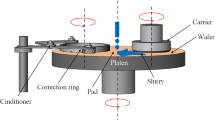Abstract
In this paper, the polishing experiment of copper was carried out. According to the experimental data, when FeCl3 was selected as oxidant, the material removal rate increases gradually with the increase of oxidant concentration. When other conditions remain unchanged, the material removal rate with larger abrasives was higher than that of smaller abrasives, and the material removal rate of pressure 3 psi was higher than that of pressure 2 psi, and the surface roughness became smaller and smaller. When the abrasive size was 1 µm, oxidant concentration was 5 g/L and the pressure was 3 psi, the material removal rate reaches 206.9 nm/min and the surface roughness reached 8 nm. When the type of oxidant was chosen as the variable, the material removal rate of the mixture of FeCl3 and H2O2 was the highest, the maximum removal rate was 105.45 nm/min when the abrasive size was 1 µm and polishing speed was 80 r/min. The surface roughness was the smallest when FeCl3 was used as oxidant and Ra reaches the smallest 5 nm under the conditions of the abrasive size was 1 µm and polishing speed 80 r/min. The results can be used as a reference for further research the ingredients of polishing slurry in the chemical mechanical polishing of copper.





Similar content being viewed by others
References
Z. Stavreva, D. Zeidler, M. Plotner, K. Drescher, Chemical mechanical polishing of copper for multilevel metallization. Appl. Surf. Sci. 91, 192–196 (1995)
T. Du, Y. Luo, V. Desai, The combinatorial effect of complexing agent and inhibitor on chemical-mechanical planarization of copper. Microelectron. Eng. 71, 90–97 (2004)
P. Wrschkaa, J. Hernandeza, Chemical mechanical planarization of copper damascene structures. J Electrochemical Soc 147(2), 706–712 (2000)
X. Wang, Y. Liu, B. Tan, Study on Cu CMP slurry. Res. Progress SSE 22(3), 318–320 (2002)
C. Yan, Y. Liu, J. Zhang et al., Integrated effects of colloidal silica abrasives with different particle sizes on copper chemical mechanical planarization. Micronanoelectronic Technol 54(1), 58–64 (2017)
X. Luan, X. Niu, Y. Liu et al., Study on the effect of the surfactant on the roughness for Cu CMP based on Arrhenius equation. Micronanoelectronic Technol 53(12), 822–827 (2016)
Y. Zhao, Y. Liu, X. Luan et al., Effects of the polishing pressure and surfactant on the uniformity in copper CMP. Semiconductor Technol 42(2), 119–123 (2017)
X. Luan, Y. Liu, C. Wang et al., A study on exploring the alkaline copper CMP slurry without inhibitors to achieve high planarization efficiency. Microelectronic Eng 160, 5–11 (2016)
K. Kawaguchi, H. Ito, T. Kuwahara et al., Atomistic mechanisms of chemical mechanical polishing of a Cu surface in aqueous H2O2: tight-binding quantum chemical molecular dynamics simulations. ACS Appl. Mater. Interfaces. 8(18), 11830–11841 (2016)
J. Su, Y. Peng, Z. Liu et al., Study on the pH value regulator of ferric chloride based slurry in chemical mechanical polishing 304 stainless steel. UPB Scientific Bulletin, Series B 79(2), 179–190 (2017)
D. Lee, H. Lee, H. Jeong, The effects of a spray slurry nozzle on copper CMP for reduction in slurry consumption. J Mechanic Sci Technol 29(12), 5057–5062 (2015)
B. Pan, R. Kang, J. Guo et al., Fabrication of thin copper substrate by double-sided lapping and chemical mechanical polishing. J Manuf Process 44, 47–54 (2019)
Y. Lou, J. Wang, H. Zhang et al., Chemical mechanical polishing of copper single crystal substrates prepared by Czochralski method. J Synth Crystals 40(6), 1418–1422 (2011)
C. Wang, Chemical-mechanical polishing process for copper consolidated abrasives (Nanjing University of Aeronautics and Astronautics, Nanjing, 2014)
S. Ramkrihnan, S. Janjam, U. Patri et al., Comparision of carboxylic acids as complexing agents for abrasive-free chemical mechanical planarization of copper. Microelectron. Eng. 84(1), 80–86 (2007)
T. Du, D. Tamboli, V. Desai, Electrochemical characterization of copper chemical mechanical polishing. Microelectronic Eng 69(1), 1–9 (2003)
S. Seal, S.C. Kuiry, B. Heinmen, Effect of glycine and hydrogen peroxide on chemical–mechanical planarization of copper. Thin Solid Films 423(2), 243–251 (2003)
Y.G. He, J.X. Wang, X.W. Gan, Y.L. Liu, Study of copper chemical mechanical polishing slurry in GLSI with low down pressure. J Hebei Univ Technol 40(3), 10–14 (2011)
X. Liu, Y. Liu, Y. Liang, H. Liu, Z. Zhao, B. Gao et al., Effect of slurry components on chemical mechanical polishing of copper at low down pressure and a chemical kinetics model. Thin Solid Films 520(1), 400–403 (2011)
L. Jiang, Y. He, X. Niu, Y. Li, J. Luo et al., Synergetic effect of benzotriazole and non-ionic surfactant on copper chemical mechanical polishing in KIO4-based slurries. Thin Solid Films 558, 272–278 (2014)
B. J. Cho, N. R. Paluvai, M. Purushothaman, J. H. Lee, S. Shima, H. Hiyama, J. G. Park. Chemical generation mechanism of copper flakes on copper wafer surface from CMP slurry and post CMP cleaning chemistry. in: ICPT 2017; International conference on planarization/CMP technology (Leuven, Belgium, 2017) pp. 1–4. VDE
Z. Zhang, J. Cui, J. Zhang, D. Liu, Z. Yu, Guo D Environment friendly chemical mechanical polishing of copper. Appl. Surf. Sci. 467–468(2), 5–11 (2019)
J.X. Su, Y.A. Peng, Z.H. Liu et al., Analysis on the action of oxidant in chemical mechanical polishing of 304 ultra-thin stainless steel. Mater. Sci. Forum 893, 234–239 (2017)
S. Jianxiu, L. Jiejing, W. Zhankui, L. Yongfeng, Lili L Chemical action in CMP 304 stainless steel based on hydrogen peroxide slurry. Acta Technica 62(4B), 1–12 (2017)
Acknowledgements
The authors acknowledge the financial support of the National Natural Science Foundation of China (No.U1804142), Science and Technology Research Project of Henan Province (No.182102210303 and No.192102210058).
Author information
Authors and Affiliations
Corresponding author
Additional information
Publisher's Note
Springer Nature remains neutral with regard to jurisdictional claims in published maps and institutional affiliations.
Rights and permissions
About this article
Cite this article
Rui, X., Yongsheng, W., Yipu, W. et al. Study on Oxidant in Chemical Mechanical Polishing of Copper. Trans. Electr. Electron. Mater. 21, 580–586 (2020). https://doi.org/10.1007/s42341-020-00208-w
Received:
Revised:
Accepted:
Published:
Issue Date:
DOI: https://doi.org/10.1007/s42341-020-00208-w




